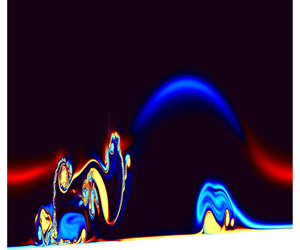Article contents
Instability and cross-boundary-layer transport by shoaling internal waves over realistic slopes
Published online by Cambridge University Press: 22 May 2020
Abstract

Internal solitary and solitary-like waves (ISW) play an important role in mixing and sediment resuspension in naturally occurring stratified fluids, primarily through various instabilities and wave-breaking mechanisms. When shoaling into shallow waters, waves of depression may either fission into a packet of waves of elevation over mild slopes or break over steep slopes. The fissioning process is generally considered a less efficient transport and resuspension mechanism, compared to wave breaking, since very little turbulent mixing or energy dissipation occurs during this process. In the present work, however, we found that this is not always the case, at least in the particular context of ISW boundary-layer interaction. Using high-resolution numerical simulations performed in a domain representing a tilted laboratory tank, we found that boundary-layer instability in the form of a separation bubble consistently occurs during the fissioning process. The separation bubble is generated beneath the wave of elevation that emerges from the fissioning process, and is vitally influenced by currents induced by the leading wave of depression. As the waves shoal further, the growth and breakdown of the separation bubble leads to significant cross-boundary-layer transport. The results suggest that the fissioning process, which occurs over a considerable geographical region in the ocean, can be as efficient as wave breaking when it comes to cross-boundary-layer transport.
- Type
- JFM Rapids
- Information
- Copyright
- © The Author(s), 2020. Published by Cambridge University Press
References
- 13
- Cited by




